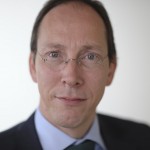 Meet Adrie Heinsbroek, Senior Sustainability Advisor at ING. He is a true believer in the power of people. “No one wakes up to make the world a worse place”, he says, “but we can all get stuck in systems that don’t help to make the world any better.” Here he shares his belief in the power of people, entrepreneurship and money as key drivers of change for a more sustainable future.
Meet Adrie Heinsbroek, Senior Sustainability Advisor at ING. He is a true believer in the power of people. “No one wakes up to make the world a worse place”, he says, “but we can all get stuck in systems that don’t help to make the world any better.” Here he shares his belief in the power of people, entrepreneurship and money as key drivers of change for a more sustainable future.
Enjoying life today and tomorrow
For me, the 1987 Brundtland definition from Our Common Future still applies: “Sustainable development is development that meets the needs of the present without compromising the ability of future generations to meet their own needs.” In a sustainable future, we’d all be happier, living more consciously and enjoying life more.
My key themes for the transition to a sustainable future are integration, impact, inclusivity and interconnection. I see a role for business in all areas, but especially in that last area of interconnection.
Integration for impact
It is all about integration of sustainability into business. In companies, CSR and sustainability need to move from the realm of charity and doing what is good for society, to also making it part of doing what is right for the business. Some talk about corporate sustainability as the license to operate, but this is still quite short-term; the conversation needs to shift to the license to exist, which is all about the long-term, about the company’s ability to sustain.
Change happens only when we really want it, when we believe it is possible and when we work very hard. Together, these three conditions create fertile ground for transition, but if there is one missing, change becomes a challenge. A lot of people are embracing change for a more sustainable future at home; recycling waste, shopping more consciously, implementing energy and water saving solutions in their homes. Yet, it requires a change in mindset to get them to be equally open to change at work, where their impact could be much larger. People need to consider the sustainability impacts of their actions at work. That would make such a huge difference!
Planting and nurturing sustainable business for the long term
My role at ING is all about connecting and integrating sustainability into the business. Inside ING, I often represent views of the outside world, and outside, I often represent the bank. The desires and demands of both parties aren’t always aligned, which makes my job a balancing act. I’m alway building bridges to create a more common understanding of what is needed and what is realistic.
 Financial institutions have tremendous opportunities to be a driver of change and progress by setting minimum standards of responsible finance that are in line with both societal expectations and sound financial metrics. At first sight, banks do not always seem to change quickly. I sometimes compare the timeline of change to that of cocoa trees : you plant them and then nurture them for five years before you can harvest cocoa beans. Like a planter, we need to constantly plant new seeds for sustainable business – and then nurture them, supported by knowledge of finance and business, as well as people inside and outside the financial industry. On the surface, change may not be so visible, but in the meantime things are developing and being prepared for the future. Banks have always played a role in the development of society.
Financial institutions have tremendous opportunities to be a driver of change and progress by setting minimum standards of responsible finance that are in line with both societal expectations and sound financial metrics. At first sight, banks do not always seem to change quickly. I sometimes compare the timeline of change to that of cocoa trees : you plant them and then nurture them for five years before you can harvest cocoa beans. Like a planter, we need to constantly plant new seeds for sustainable business – and then nurture them, supported by knowledge of finance and business, as well as people inside and outside the financial industry. On the surface, change may not be so visible, but in the meantime things are developing and being prepared for the future. Banks have always played a role in the development of society.
Change requires brave leaders
Change requires leaders with strong business ethics, who can engage both young and old. Combining new talent with seasoned leaders in the company, they create a powerful force for good. What we don’t need are leaders who just take the high moral ground and speak at us from a distance, pointing their fingers at others. We need leaders who are willing to push us until a point where it starts to hurt; to confront us with places where it starts to be difficult. And who then work with people to find solutions and drive change. This is where new,more sustainable business models start to replace old models; this is where financial institutions play a role.
ING’s sustainability strategy: integration for impact
Looking into the future, I come back to some key themes from before: integration and impact. Increasingly, we are anchoring sustainability in the corporate business strategy, rather than in a separate sustainability strategy. This also enables us to report on our policies and responsible lending practices in an integrated way, creating insight into our impact and the tactics we’re employing to reduce negative impacts and build on positive ones.
Integrated thinking and reporting are pushing us to accept the consequences of our business model, and the value created by financial institutions for society. It forces us to think about what we should start, continue or stop doing to really improve our impact. It forces us to focus on areas where we can really have an impact, rather than trying to carry all the weight of the world on our shoulders and spread ourselves too thin.
Banks can create irreversible, systemic change
Working in the financial industry is not about disruptive change, but rather about structured change, starting at the policy level and then putting it into practice in servicing clients. Society is changing rapidly and banks should be part of that change to continuously prove their relevance to clients and society. I am sometimes frustrated with the pace of change, but there are other things I really like about change in a financial institution like ING. It is irreversible and has huge potential to be scaled, due to our balance sheet and broad global client base in combination with our long-term, sustainable, perspective on both business and society.
For more information, follow Adrie on LinkedIn or follow @ING_news on Twitter.
Written by Marjolein Baghuis (@mbaghuis)

Now on my blog: an inside perspective on working in #sustainablity at a large bank http://t.co/RRyCNHnUFZ
New on my blog: No one wakes up to destroy the world: inside perspective on driving #sustainable #change at ING Bank http://t.co/RRyCNHnUFZ